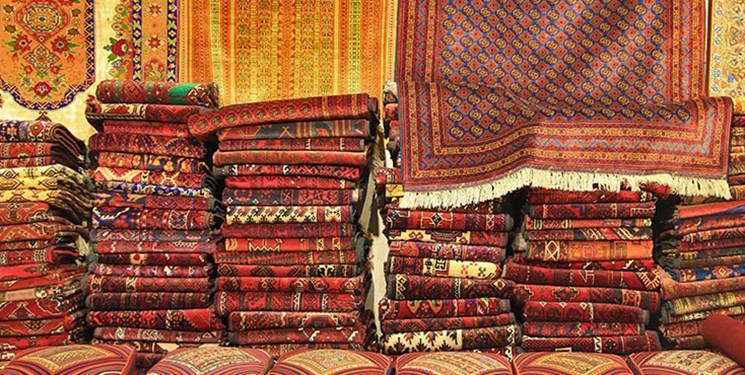Iran’s handwoven carpet production increased by 34% in the first 10 months of last Iranian year (March 20, 2020-Jan. 21) compared with the similar period of the preceding year, the head of National Carpet Center said.
Farahnaz Rafe’ added that 1,869,304 square meters of handwoven carpets were produced in Iran during the period while the figure for the same period of the previous year was 1,231,321 square meters, SHATA news reported.
“Forty-two percent of the carpets were commercial, 19% thick-knot, 16% subtle-knot and wool, 9% tapestry, 8% Gabbeh and 6% full-silk carpets,” she was quoted as saying by Fars News Agency.
She noted that 10,140 Iranian units are active in handmade carpet production, among which 2,787 are centralized workshops, 7,256 non-centralized workshops and 97 are large carpet weaving complexes.
In February, Rafe’ said Iran’s export of hand-woven carpet increased in area (square meters) by 14% compared to last year.
But according to Ruohollah Latifi, the spokesperson of the Islamic Republic of Iran Customs Administration, Iran exported hand-woven carpets worth $47.91 million during the eight months to Nov. 20,
“Carpet exports decreased by $755,000 compared with the similar period of last year, which seems reasonable given the outbreak of coronavirus and closure of borders,” he was quoted as saying by IRNA.
7.9% Share in Global Exports
Global handwoven carpet exports amounted to $1 billion in 2019, with Iran accounting for a 7.9% share, according to IRNA.
While global exports in handwoven carpets hit $1.45 billion in 2016, the number has been declining continually in recent years.
Iran had a share of 7.9% in the handwoven carpet exports market in 2019 when India was the top exporter with a 31.7% share, followed by Egypt with 18.2%.
Ranking third, Iran was followed by Nepal with 6.5%, Pakistan with 6.2%, Turkey with 4.7% and China with 3.8%.
A total of $50 million worth of hand-woven carpets were exported from Iran in the fiscal 2019-20, registering a 90% decline compared with the previous year.
“This decline in exports has many reasons, the main ones being US sanctions as well as the Central Bank of Iran’s stipulation that traders repatriate the foreign currency gained from exports, which significantly increases the risk of trade and discourages exporters,” CEO of the National Association for Handmade Carpet Producers Cooperatives Abdollah Bahrami was also quoted as saying by Fars News Agency.
As per the CBI directive devised in the wake of a currency crisis in Iran, the government has obliged all exporters to repatriate their foreign currency yields into the economic cycle of the country.
The move is aimed at boosting strained currency reserves in the short run, under difficult economic conditions. But it has understandably received negative feedback from private sector players.
“Up until two decades ago, the country used to earn more than $1.5 billion from handmade carpet exports, but today we have lost our position as the world’s biggest carpet exporter. It is well known that when you lose an export market, you can’t easily take it back,” a private carpet exporter said.
Carper Sale on Credit
A trilateral memorandum of understanding was recently signed by Omid Entrepreneurship Fund, Iran National Carpet Center and the private sector for creating sustainable jobs and lending support to the hand-woven carpet market.
As per the MoU, hand-woven carpets will be sold on credit to Iranian households as of next fiscal year (starting March 21), the head of National Carpet Center was quoted as saying by Mehr News Agency.
“With loans worth 500 million rials [about $2,000] granted by Omid Entrepreneurship Fund, Iranian households will be able to buy hand-woven carpets,” Rafe’ said.
“Upwards of one million jobs will be created if they buy at least one carpet each.”
In collaboration with Qarz Al-Hassaneh Mehr Iran Bank, loans worth up to 300 million rials [$1,200] with an interest rate of 4% will be paid for the Complementary Health Insurance of carpet weavers.
According to Rafe’, 261,000 carpet weavers are under the coverage of the Social Security Organization insurance.
Omid Entrepreneurship Fund supports entrepreneurship and small and medium enterprises. The fund’s loans are mostly extended to less developed and rural areas plus small towns deprived of credit from banks.
Asghar Nourollahzadeh, the fund’s CEO, recently said the fund has offered 81,228 loans worth 18,500 billion rials ($75 million) since the beginning of last Iranian year (March 20, 2020).
“Of this figure, 14,810 billion rials [$60 million] have been lent to support businesses hurt by the outbreak of coronavirus,” he said.
“A total of 1,250 gymnasiums, 1,800 eco-lodges, 200 restaurants and 500 greenhouse complexes have received financial support from the fund.”
As per the budget bill for the new fiscal year (March 2021-22), the government will allocate 155.5 billion rials ($600,000) to improve the country’s share in hand-woven carpet exports through local and international marketing. It has also projected a 50-billion-rial ($200,000) financial support for Iran’s Hand-Woven Rural Central Union.


